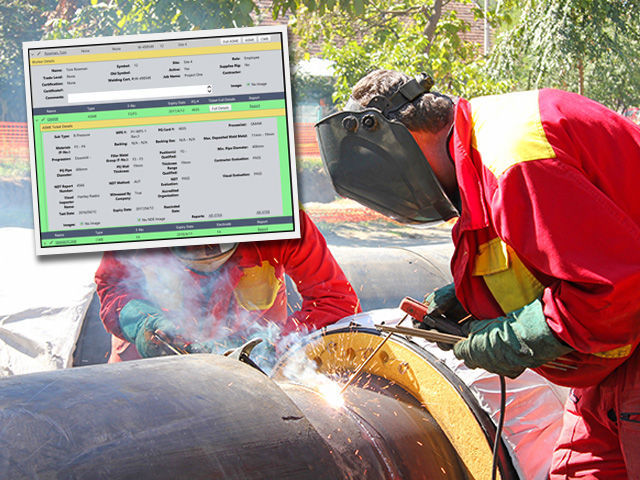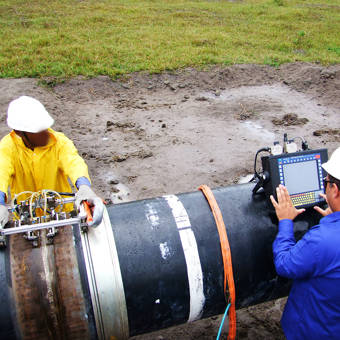Comprehensive Review of Pipeline Welding Evaluation Procedures
Pipe welding examination procedures play a critical duty in assuring that bonded links satisfy rigorous industry criteria and specs. From thorough pre-welding evaluations to thorough post-weld evaluations, a well-defined examination procedure is crucial for maintaining the architectural strength of pipelines.
Pre-welding Assessment Preparations
Before starting the welding procedure, detailed pre-welding examination prep work are important to ensure the honesty and quality of the weld joint. These prep work include a precise evaluation of the products to be welded, the welding devices, and the workplace. First of all, the products need to be checked for any type of issues, pollutants, or incongruities that might endanger the weld. This consists of monitoring for proper material qualities, measurements, and surface area problems. Pipeline Welding Inspection. Furthermore, the welding equipment needs to be checked to confirm that it is in good functioning condition, adjusted properly, and suitable for the specific welding procedure. Any kind of concerns with the tools should be attended to quickly to avoid issues in the weld. The job setting have to be evaluated for cleanliness, correct air flow, and safety procedures to make certain a favorable setup for the welding operation. By carrying out detailed pre-welding assessment preparations, possible problems can be recognized and settled beforehand, bring about top notch and trusted weld joints.
Welding Procedure Certification
Comprehensive pre-welding examination preparations lay the foundation for the vital procedure of Welding Procedure Certification, making sure the stability and quality of the weld joint. Welding Treatment Qualification (WPQ) is an essential step in the welding procedure that includes screening and licensing welding treatments to ensure they fulfill particular criteria and requirements. The WPQ process usually includes welding treatment requirements development, welding procedure qualification screening, and documentation of the results.
Throughout welding treatment specification development, vital details such as the welding procedure, welding products, joint design, and welding criteria are defined to develop an extensive procedure. Consequently, welding treatment qualification testing is performed to verify the suggested procedure's stability. This testing usually entails welding test promo codes that undergo different mechanical and non-destructive tests to assess the weld's high quality and adherence to the defined requirements.
In-process Weld Examination
Throughout the welding procedure, in-process weld assessment plays an essential function in making certain the high quality and stability of the weld joint - Pipeline Welding Inspection. This kind of evaluation includes keeping track of the welding specifications, examining the weld bead development, and discovering any kind of potential flaws or stoppages as they happen. By conducting in-process weld examinations, welding drivers can quickly address any kind of concerns that may arise, therefore ensuring and protecting against more problems that the click this final weld satisfies the required requirements
Typical methods made use of for in-process weld evaluation consist of visual examination, liquid penetrant screening, magnetic particle screening, ultrasonic screening, and radiographic testing. On the whole, in-process weld examination is essential for keeping the high quality and dependability of welded pipes.
Non-destructive Screening (NDT)
Non-destructive Testing (NDT) is a vital technique used in pipeline welding assessment to assess the stability of weld joints without creating damage to the welded structure. By making use of various NDT methods, assessors can review the quality of welds and determine click to investigate any kind of defects or gaps that might endanger the architectural stability of the pipeline. Typical NDT approaches made use of in pipe welding inspection include Radiographic Testing (RT), Ultrasonic Screening (UT), Magnetic Fragment Examining (MPT), Liquid Penetrant Testing (LPT), and Visual Testing (VT)
RT involves the use of X-rays or gamma rays to create photos of the interior framework of the weld, enabling inspectors to spot defects such as porosity, cracks, or incomplete combination. UT makes use of high-frequency sound waves to find problems beneath the surface of the weld, using in-depth info concerning the dimension and place of flaws. MPT and LPT are utilized to recognize surface-breaking problems by applying magnetic bits or penetrant liquids to the weld location. In addition, VT includes visual evaluation of welds to determine any visible blemishes.
Post-weld Evaluation and Paperwork


Documentation of post-weld examination searchings for official source is necessary for keeping high quality control documents and making sure compliance with market criteria and guidelines. Detailed records need to include details about the assessment methods utilized, the area and nature of any flaws found, and any type of rehabilitative actions taken - Pipeline Welding Inspection. Appropriate documents not only works as a document of the weld's quality however additionally help in future maintenance and assessment procedures
Conclusion

In conclusion, pipe welding inspection procedures play an important function in making sure the top quality and honesty of welds. On the whole, adherence to proper inspection protocols is key to the success of pipeline welding projects.
From meticulous pre-welding inspections to extensive post-weld assessments, a well-defined inspection procedure is essential for keeping the architectural sturdiness of pipes. By carrying out in-process weld assessments, welding operators can promptly resolve any type of problems that might occur, therefore making sure and preventing further issues that the last weld satisfies the required requirements.
Common approaches used for in-process weld assessment consist of aesthetic evaluation, fluid penetrant screening, magnetic fragment testing, ultrasonic screening, and radiographic screening.Non-destructive Testing (NDT) is an important approach used in pipe welding assessment to evaluate the integrity of weld joints without causing damages to the bonded structure. Post-weld examination includes numerous approaches to examine the welds for problems, including visual assessment, dye penetrant testing, magnetic particle screening, ultrasonic screening, and radiographic testing.